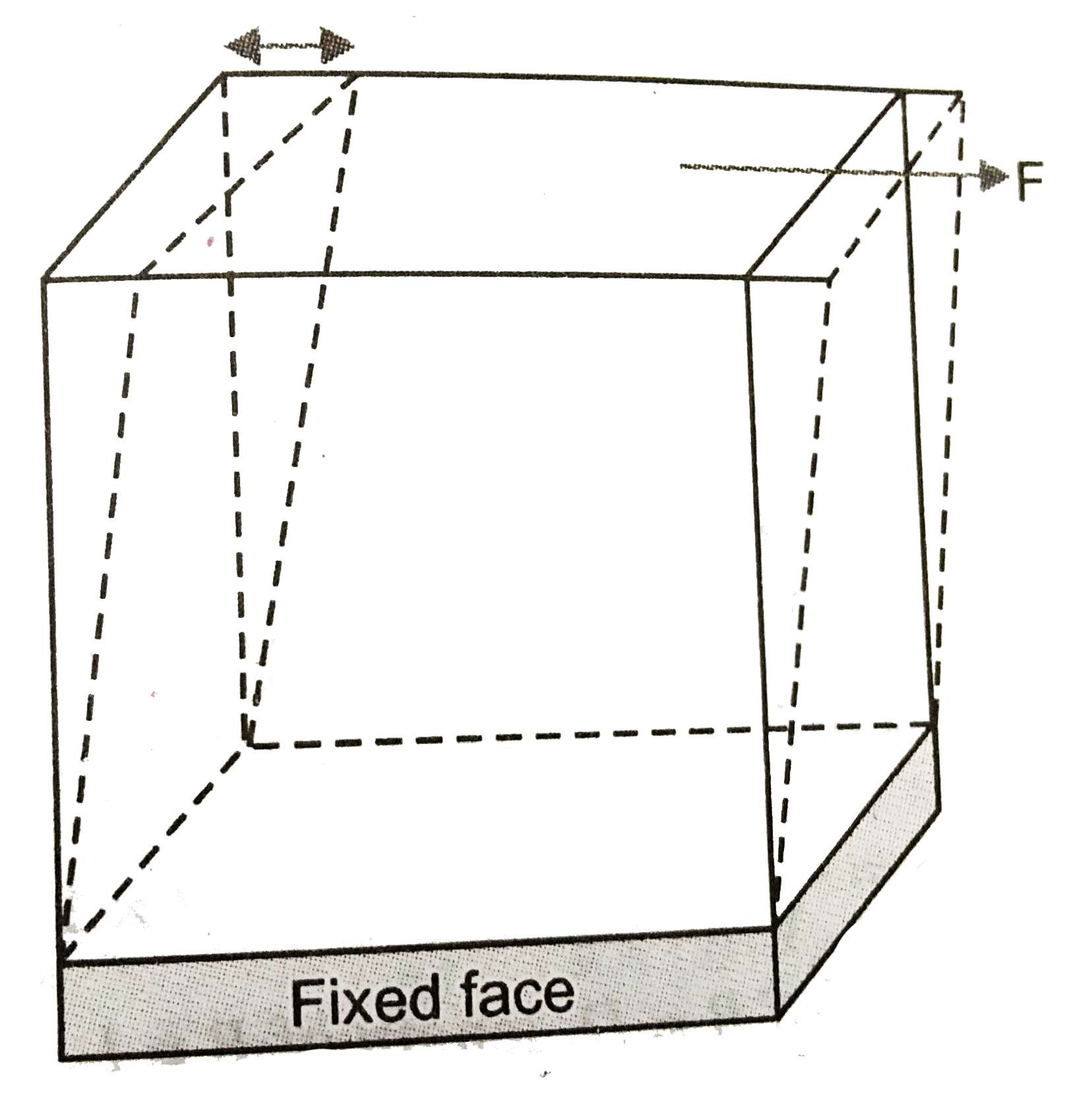A square lead slab of side 50 cm and thickness 10 cm is subject to a shearing force (on its narrow face) of 9.0×104N. The lower edge is riveted to the floor How much will the upper edge be displaced ?
The lead slab is fixed and the force is applied parallel to the narrow face as shown in Fig. 9.7. The area of the face parallel to which this force is applied is
A=50 cm ×10 cm
=0.5 m×0.1 m
=.05 m2
Therefore, the stress applied is
=(9.4×104N/00.5 m2)
=1.8×106 N.m−2

We know that shearing strain =(Δx/L)= Stress/G.
Therefore the displacement Δx=(Stress ×L)/G
=(1.8×106 N m−2×0.5m)/(5.6×109 N m−2)
=1.6×10−4m=0.16 mm
Topper's Solved these Questions
- MECHANICAL PROPERTIES OF SOLIDS BOOK - NCERT BANGLISHCHAPTER - MECHANICAL PROPERTIES OF SOLIDS EXERCISE - Exercises
16 Videos
- MECHANICAL PROPERTIES OF FLUIDS BOOK - NCERT BANGLISHCHAPTER - MECHANICAL PROPERTIES OF FLUIDS EXERCISE - EXERCISE
43 Videos
- MOTION IN A PLANEBOOK - NCERT BANGLISHCHAPTER - MOTION IN A PLANEEXERCISE - EXCERCISES
30 Videos
Similar Questions
A square lead slab of side 50 cm and thickness 10 cm is subjected to a shearing force (on its narrow face) of 9×104N. The lower edge is riveted to the floor. How much will the upper edge be displaced? (Shear modulus of lead=5.6×109Nm−2)
View SolutionA square lead slab of side 50cm and thickness 5.0cm is subjected to a shearing force (on its narrow face) of magnitude 9.0×104 N. The lower edge is riveted to the floor. How much is the upper edge displaced, if the shear modulus of lead is 5.6×1090 Pa?
View Solution
Knowledge Check
A square lead slab of side 50 cm and thickness 10 cm is subjected to a shearing force (on its narrow face) of 9×104N. The lower edge is riveted to the floor. How much will the upper edge be displaced? (Shear modulus of lead=5.6×109Nm−2)
A0.16mmB1.6mmC0.16 cmD1.6 cmA square lead slab of side 50 cm and thickness 10 cm is subjected to a shearing force (on its narrow face) of 9×104N. The lower edge is riveted to the floor. How much will the upper edge be displaced? (Shear modulus of lead=5.6×109Nm−2)
A0.16 mmB1.6 mmC0.16 cmD1.6 cmA square lead slab of side 50 cm and thickness 10 cm is subjected to a shearing force of 9.0×104N. The lower edge of the slab is fixed to the floor. The upper edge of the slab is displaced by 0.16mm . The Youn's modulus for the lead is
 A1.9×109N/m2B1.7×1010N/m2C1.1×1010N/m2D5.6×109N/m2
A1.9×109N/m2B1.7×1010N/m2C1.1×1010N/m2D5.6×109N/m2
A square lead slab of side 50cm and thickness 5.0cm is subjected to a shearing force (on its narrow face) of magnitude 9.0×104 N. The lower edge is riveted to the floor. How much is the upper edge displaced, if the shear modulus of lead is 5.6×1090 Pa?
View SolutionA square lead slab of sides 50cm and thickness 5.0cm is subjected to a shearing force ( on its narrow face ) of magnitude 9.0×104N . The lower edge is riveted to the floor. How much is the upper edge displaced if the shear modulus of lead is 5.6×109Pa ?
View SolutionA square aluminium of side 50cm and thickness 5cm is subjected to a shearing force of magnitude 104N. The lower edge is revetted to the floor. How much is the upper edge displaced if shear modulus of aluminium is 2.5×1010Nm−2 ?
View SolutionA lead cube of side 20 cm is subjected under a shearing force of magnitude 5.6x106N. If the lower face of the cube is fixed, then the displacement in the upper face is (If shear modulus of lead is 5.6⋅106Nm2)
View SolutionA lead cube of side 20 cm is subjected under a shearing force of magnitude 5.6x106N. If the lower face of the cube is fixed, then the displacement in the upper face is (If shear modulus of lead is 5.6⋅106Nm2)
View Solution
